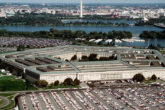November 18, 2021
For JADC2 to Have a Chance, DoD Needs to Get Serious About Data Standards
We are past the tipping point where information and decision-centric capabilities are more important instruments of war than kinetic weapons. That is to say, victory in future high-intensity conflicts may no longer hinge on who has the best warships, planes, and tanks, but rather on who can better harness information to act faster and more effectively than their adversary.
The Defense Department is betting that its emerging Joint All-Domain Command & Control (JADC2) concept— which seeks to connect sensors, deciders, and shooters from across all services and domains into a theater-wide, or even global, battle network — will provide the US military with just such an advantage should a war against a near military peer like China or Russia break out sometime in the future. But actually implementing JADC2 will force the Department to grapple with significant technological and interoperability challenges.
A recent analysis by Govini found that over the past five years the Defense Department has spent billions of dollars on developing and procuring Command, Control, Communications, Computers, and Information (C4I) capabilities.
We are past the tipping point where information and decision-centric capabilities are more important instruments of war than kinetic weapons.
In theory, that’s a good thing: C4I capabilities are critical to JADC2 because they will function, in effect, as its central nervous system. However, the bulk of the spending has been concentrated on major service programs, such as the Army’s Integrated Air and Missile Defense Battle Command System (IBCS) and the Navy’s Consolidated Afloat Network and Enterprise Services (CANES), with 33% of all JADC2-related spending going to just five major C4I programs.
As a result, the Department faces a two-sided interoperability challenge.
First, the service C4I systems procured over the period were not necessarily designed with joint interoperability in mind. And given the high level of expenditures on these programs, it will be difficult—if not impossible—for the department to simply scrap these systems and start over with a singular joint solution. The department will need to figure out how to integrate these existing systems into a cohesive JADC2 battle network.
And while those poorly coordinated procurement decisions are ongoing, the majority of spending in this area has shifted towards developing the next generation of C4I capabilities. Unfortunately, those development efforts have also been stove-piped — creating the second interoperability challenge.
Read the full article from Breaking Defense.
More from CNAS
-
Lessons in Learning
Executive Summary Although claims of a revolution in military affairs may be overhyped, the potential for artificial intelligence (AI) and autonomy to change warfare is growin...
By Josh Wallin
-
The Pentagon Push to Change an “Antiquated” System
Carlton Haelig, a fellow at the Center for a New American Security, joined The Cipher Brief to discuss the systems in place in the Department of Defense and the challenges ass...
By Carlton Haelig
-
The Department of Defense’s Breakthrough Nuclear Moment Risks Slipping Away
Unless they act, the Department of Defense’s breakthrough nuclear moment may vanish before it really happens....
By Will Rogers
-
DEFAERO Strategy Series [Apr 09, 25] CNAS' Becca Wasser and Phil Sheers on Revitalizing the U.S. Defense Industrial Base
On this episode of the Defense & Aerospace Report Strategy Series, sponsored by General Atomics Aeronautical Systems, Becca Wasser and Phil Sheers of the Center for a New Amer...
By Becca Wasser & Philip Sheers




